Tuscaloosa, AL Pollen and Allergy Report for Summer 2023
Pollen Allergy Trends in Tuscaloosa, AL
When is pollen lowest in Tuscaloosa, AL?

February
Lowest month total PPM
Avg. PPM
When is pollen highest in Tuscaloosa, AL?

March
Highest month total PPM
Avg. PPM
How does pollen in Tuscaloosa, AL compare to Alabama?
Tuscaloosa has a higher average PPM than the state of Alabama.
Tuscaloosa yearly avg PPM:
Alabama yearly avg PPM:
How does pollen in Tuscaloosa, AL compare to the USA?
Tuscaloosa has a higher average PPM than the USA.
Tuscaloosa yearly avg PPM:
USA yearly avg PPM:
Is pollen worse this year in Tuscaloosa, AL?
Spring 2023 was about the same as 2022.
Spring 2023 PPM:
Spring 2022 PPM:
Average PPM in Tuscaloosa, AL


Tuscaloosa, AL Pollen and Allergy Breakdown by Month
Grass
When is grass pollen highest in Tuscaloosa, AL?
April has the highest grass pollen in Tuscaloosa, AL with an average PPM of
When is grass pollen lowest in Tuscaloosa, AL?
December has the lowest grass pollen in Tuscaloosa, AL with an average PPM of
Tree
When is tree pollen highest in Tuscaloosa, AL?
March has the highest tree pollen in Tuscaloosa, AL with an average PPM of
When is tree pollen lowest in Tuscaloosa, AL?
September has the lowest tree pollen in Tuscaloosa, AL with an average PPM of
Weed
When is weed pollen highest in Tuscaloosa, AL?
April has the highest weed pollen in Tuscaloosa, AL with an average PPM of
When is weed pollen lowest in Tuscaloosa, AL?
February has the lowest weed pollen in Tuscaloosa, AL with an average PPM of
Tuscaloosa, AL Pollen Monthly Breakdown by Pollen Type
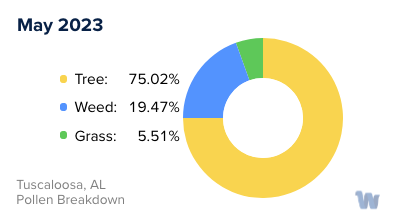
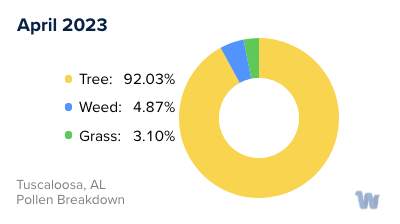

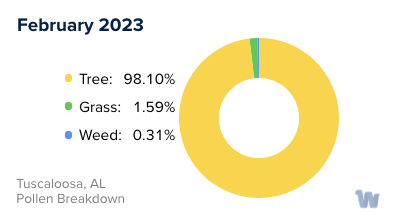
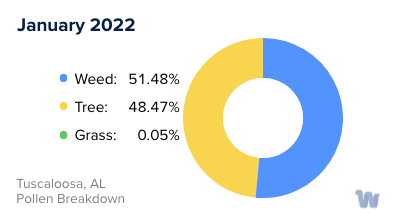
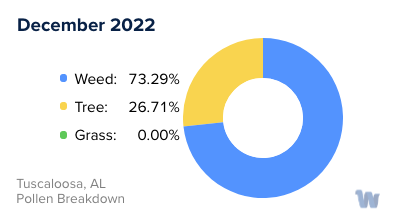

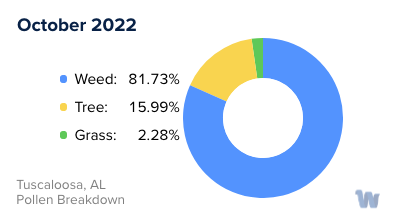
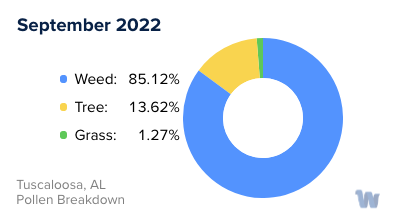
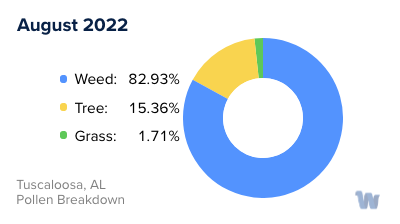

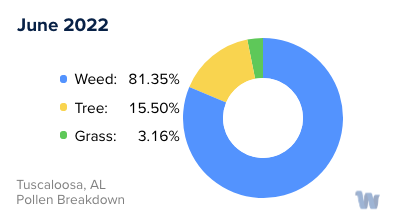

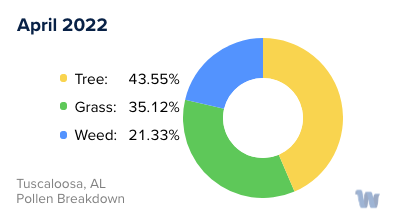


Pollen and Hay Fever in Tuscaloosa, AL
In Tuscaloosa, Alabama, the beauty of the changing seasons comes with a downside for many residents: pollen allergies. Commonly known as hay fever, pollen allergies occur when the immune system reacts to pollen grains in the air. As the seasons transition, various plants release these tiny particles to fertilize other plants. This natural process is essential for plant reproduction, but for allergy sufferers, it can cause a cascade of symptoms like sneezing, itchy eyes, and a runny nose.
In Tuscaloosa, there are three primary types of pollen that are the culprits behind hay fever: tree pollen, grass pollen, and weed pollen. Each type has its peak season, making pollen allergies a year-round concern for some individuals.
Tree pollen is most prevalent in the spring. As trees awaken from their winter slumber, they release copious amounts of pollen into the air. Oak, pine, and cedar are some of the common trees in Tuscaloosa whose pollen can trigger allergies.
As spring gives way to summer, grass pollen takes center stage. Bermuda grass, bahia grass, and Kentucky bluegrass are common in Tuscaloosa, and their pollen levels surge during the late spring and early summer months.
Lastly, weed pollen becomes prominent as summer transitions into fall. Ragweed is a prime offender in Tuscaloosa, releasing pollen from late summer to mid-fall.
In Tuscaloosa, it's essential to be aware of the types of pollen and their respective seasons. By understanding when certain pollens are prevalent, residents can better anticipate and manage their allergy symptoms without compromising their enjoyment of the city’s natural beauty.


